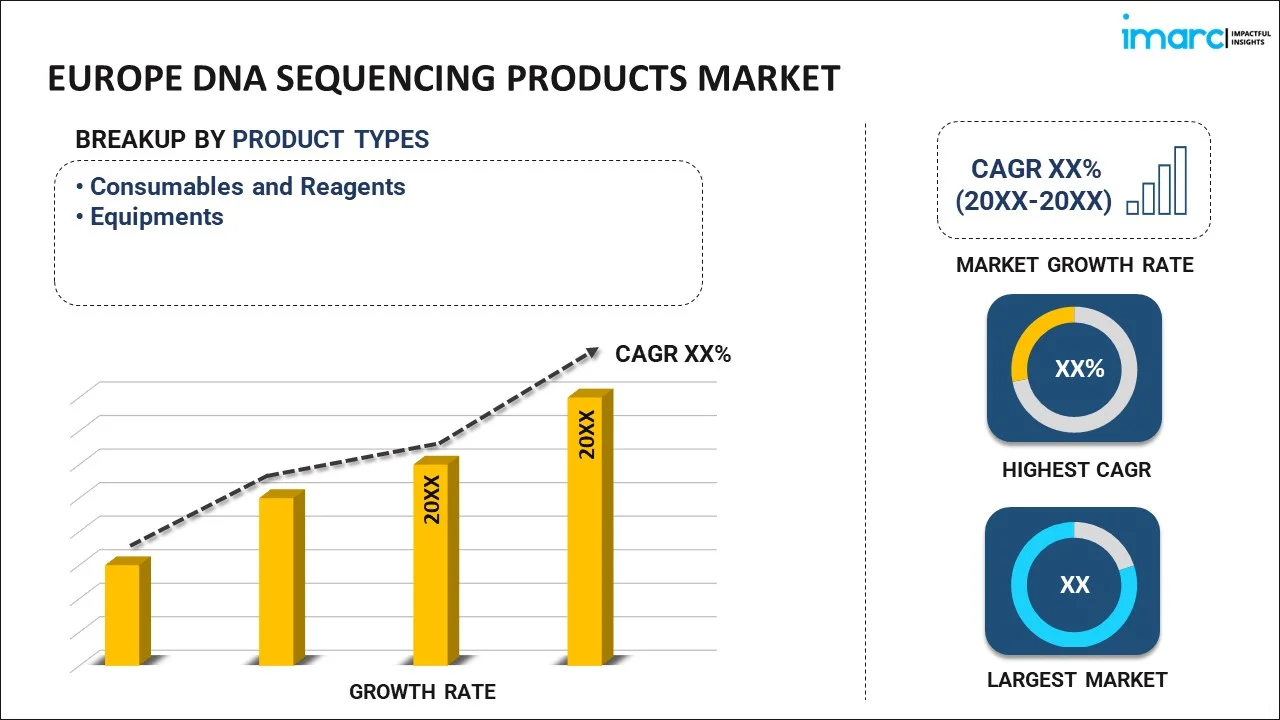
Europe DNA Sequencing Products Market Report by Product Type (Consumables and Reagents, Equipments), Application (Biomarkers, Diagnostics, Reproductive Health, Forensics, Personalized Medicine, and Others), End User (Academic and Government Research Institutes, Pharmaceutical and Biotechnology Companies, Hospitals and Clinics, and Others), and Country 2025-2033
Market Overview:
The Europe DNA sequencing products market size reached USD 2.5 Billion in 2024. Looking forward, IMARC Group expects the market to reach USD 8.6 Billion by 2033, exhibiting a growth rate (CAGR) of 13.84% during 2025-2033.
|
Report Attribute
|
Key Statistics
|
|---|---|
|
Base Year
|
2024
|
|
Forecast Years
|
2025-2033
|
|
Historical Years
|
2019-2024
|
|
Market Size in 2024
|
USD 2.5 Billion |
|
Market Forecast in 2033
|
USD 8.6 Billion |
| Market Growth Rate 2025-2033 | 13.84% |
DNA sequencing refers to the process of identifying the order of nucleotides in the deoxyribonucleic acid (DNA). These nucleotides include adenine (A), guanine (G), cytosine (C) and thymine (T), which are the building blocks of nucleic acids. This method assists researchers to diagnose multiple DNA linked disorders or congenital malformations in individuals. In line with this, DNA sequencing products are generally used to automate the sequencing process with improved efficacy. As a result, they help researchers in understanding the complex structure of diseases and in the manufacturing of personalized medicines.
The market in Europe is primarily driven by significant growth in the genomics industry. Along with this, the increasing investments by private firms and governments of numerous countries in order to upgrade the existing bioinformatics infrastructure across the region are creating a positive outlook for the market. Moreover, continual technological advancements in the sector, such as the introduction of Immensa Genomic Interpretation Software that helps researchers interpret the genome sequencing data for the purpose of pharmacogenomics and nutrigenomics, is also providing a boost to the market growth. Some of the other factors contributing to the market growth across the region include the miniaturization of DNA sequencing products and extensive research and development (R&D) activities.
Key Market Segmentation:
IMARC Group provides an analysis of the key trends in each sub-segment of the Europe DNA sequencing products market report, along with forecasts at the regional and country level from 2025-2033. Our report has categorized the market based on product type, application and end user.
Breakup by Product Type:

- Consumables and Reagents
- Equipments
Breakup by Application:
- Biomarkers
- Diagnostics
- Reproductive Health
- Forensics
- Personalized Medicine
- Others
Breakup by End User:
- Academic and Government Research Institutes
- Pharmaceutical and Biotechnology Companies
- Hospitals and Clinics
- Others
Breakup by Country:
- Germany
- France
- United Kingdom
- Italy
- Spain
- Others
Competitive Landscape:
The competitive landscape of the industry has also been examined along with the profiles of the key players.
Report Coverage:
| Report Features | Details |
|---|---|
| Base Year of the Analysis | 2024 |
| Historical Period | 2019-2024 |
| Forecast Period | 2025-2033 |
| Units | Billion USD |
| Segment Coverage | Product Type, Application, End User, Country |
| Countries Covered | Germany, France, United Kingdom, Italy, Spain, Others |
| Customization Scope | 10% Free Customization |
| Post-Sale Analyst Support | 10-12 Weeks |
| Delivery Format | PDF and Excel through Email (We can also provide the editable version of the report in PPT/Word format on special request) |
Key Questions Answered in This Report:
- How has the Europe DNA sequencing products market performed so far and how will it perform in the coming years?
- What has been the impact of COVID-19 on the Europe DNA sequencing products market?
- What are the key regional markets?
- What is the breakup of the market based on the product type?
- What is the breakup of the market based on the application?
- What is the breakup of the market based on the end user?
- What are the various stages in the value chain of the industry?
- What are the key driving factors and challenges in the industry?
- What is the structure of the Europe DNA sequencing products market and who are the key players?
- What is the degree of competition in the industry?
Need more help?
- Speak to our experienced analysts for insights on the current market scenarios.
- Include additional segments and countries to customize the report as per your requirement.
- Gain an unparalleled competitive advantage in your domain by understanding how to utilize the report and positively impacting your operations and revenue.
- For further assistance, please connect with our analysts.
 Inquire Before Buying
Inquire Before Buying
 Speak to an Analyst
Speak to an Analyst
 Request Brochure
Request Brochure
 Request Customization
Request Customization




.webp)




.webp)












